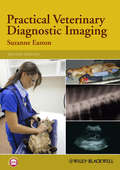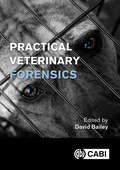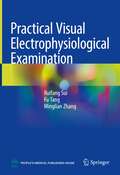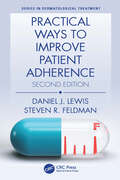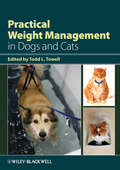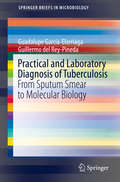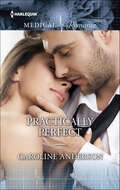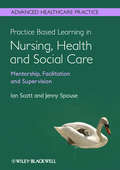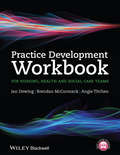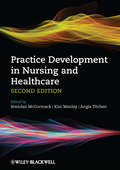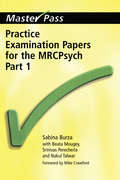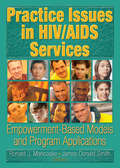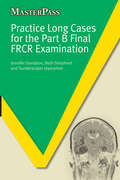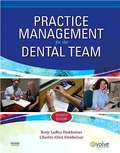- Table View
- List View
Practical Veterinary Diagnostic Imaging
by Suzanne EastonPractical Veterinary Diagnostic Imaging is an essential and practical guide to the various diagnostic imaging modalities that are used in veterinary practice. It moves from basic mathematic and physical principles through to discussion of equipment and practical methods. Radiographic techniques for both small and large animals are covered. There is a separate chapter devoted to ultrasound, as well as discussion of advanced imaging techniques such as fluoroscopy, computerised tomography and magnetic resonance imaging. The book also covers legislation and safety issues in the context of their impact on the veterinary practice.Presented with clear line diagrams and photographs, Practical Veterinary Diagnostic Imaging also provides revision points and self-assessment questions in each chapter to aid study. It is an ideal guide for student and qualified veterinary nurses. It is also a useful reference for veterinary students and veterinarians in general practice who want a basic guide to radiography and other imaging modalities.KEY FEATURESEverything you need to know about diagnostic imaging in veterinary practice in a language you can easily understandThe basic principles of physics presented in simple termsImproves your positioning techniques with practical tips for best practiceClear guidance on the use of digital imaging to improve image quality and reduce radiation doses to patientsCompanion website with additional resources (available at www.wiley.com/go/easton/diagnosticimaging)
Practical Veterinary Forensics
by David Bailey Claire Gwinnet Dr Deborah Rook Ernest Rogers Dr Rachel Bolton-King Dr Pippa Swan Dr Adele Wharton Dr Lucy Leicester Dr Claire Gwinnett Lloyd Reeve-Johnson Dr Jenny Hamilton-Ible Nikolaos Kolatzis Karl Harrison Rachel Bolton King Dr Johan Schulze Steven White Dr Louise MacleodVeterinarians often come into contact with the law in cases of animal cruelty, domestic animal and wildlife crimes, and human crimes with an animal element. This book provides practical information and training on how to operate within a crime scene. It covers the tests that may need to be carried out, collecting evidence, preparing reports and giving evidence in court as an expert witness. Concentrating on the basic principles and background knowledge needed, the book includes hair, blood and bite mark analysis as well as an overview of firearms injury. It explores wider concepts such as the human-animal bond and one health, going on to give practical guidance and numerous case studies, which bring the book to life and into the real world of the busy crime scene. Practical Veterinary Forensics is an indispensable guide to all veterinarians working in cases of animal cruelty, abuse and crimes against animals. It is essential for welfare organizations, animal shelters and those requiring an introduction to veterinary forensic science.
Practical Veterinary Forensics
by Claire Gwinnet Dr Deborah Rook Ernest Rogers Dr Rachel Bolton-King Dr Pippa Swan Dr Adele Wharton Dr Lucy Leicester Dr Claire Gwinnett Lloyd Reeve-Johnson Dr Jenny Hamilton-Ible Nikolaos Kolatzis Karl Harrison Rachel Bolton King Dr Johan Schulze Steven White Dr Louise MacLeodVeterinarians often come into contact with the law in cases of animal cruelty, domestic animal and wildlife crimes, and human crimes with an animal element. This book provides practical information and training on how to operate within a crime scene. It covers the tests that may need to be carried out, collecting evidence, preparing reports and giving evidence in court as an expert witness. Concentrating on the basic principles and background knowledge needed, the book includes hair, blood and bite mark analysis as well as an overview of firearms injury. It explores wider concepts such as the human-animal bond and one health, going on to give practical guidance and numerous case studies, which bring the book to life and into the real world of the busy crime scene. Practical Veterinary Forensics is an indispensable guide to all veterinarians working in cases of animal cruelty, abuse and crimes against animals. It is essential for welfare organizations, animal shelters and those requiring an introduction to veterinary forensic science.
Practical Veterinary Urinalysis
by Nicole M. Weinstein Carolyn A. SinkPractical Veterinary Urinalysis is a comprehensive, clinically relevant resource for the veterinary laboratory. This bench-top guide covers sample handling guidelines, interpretation of dry chemical analysis, and recommendations for physical and microscopic evaluation. Emphasizing diagnostic techniques and result interpretation, Practical Veterinary Urinalysis is an ideal aid for anyone who performs and interprets urinalysis testing. Beginning with an overview of renal physiology and urine production, the main focus of the book is examination and analysis of urine samples, including physical properties, chemical analysis, and sediment examination. Additional chapters review diagnostic tests and considerations for proteinuria, advanced diagnostics, quality assurance and laboratory set-up. Practical Veterinary Urinalysis is an invaluable tool for achieving accurate and reliable laboratory results and is a useful addition to any veterinary library.
Practical Visual Electrophysiological Examination
by Ruifang Sui Fu Tang Minglian ZhangThis book includes the concept, general summary and the equipment of the visual electrophysiological examination. It also covers the clinical application scope, diagnosis protocol, standardized operation steps, clinical report samples, and the key points of reading reports, etc. of visual evoked potential (VEP), electroretinogram (ERG), electrooculogram (EOG), multifocal VEP, multifocal ERG and other commonly used visual electrophysiological examinations. Typical clinical report examples of normal and abnormal waveforms are specially added, which is a highlight of this book and can help clinical technicians quickly grasp the key points of electrophysiological report reading.
Practical Ways to Improve Patient Adherence (Series in Dermatological Treatment)
by Daniel J Lewis Steven R FeldmanThe New York Times has called adherence the world’s "other drug problem." Physicians prescribe medications, but patients do not always use them. While it would be easy for physicians to blame patients for treatment failures, physicians can do more to motivate patients to use their medications as recommended. Practical Ways to Improve Patient Adherence, Second Edition, is an excellent resource for physicians and allied health professionals whose patients exhibit poor adherence. Daniel J. Lewis, MD (Department of Dermatology, University of Pennsylvania Health System), and experienced adherence researcher, Steven R. Feldman, MD, PhD (Departments of Dermatology and Social Sciences & Health Policy, Wake Forest University School of Medicine), examine the problem of poor adherence and offer concrete techniques to encourage patients to use their medications and improve treatment outcomes. This book offers novel, potent ways to get patients to use their medications and improve treatment outcomes – tools healthcare providers can use day in and day out. A medical education is not complete without a thorough understanding of the hurdles that contribute to poor adherence and what health professionals can and should do about it. "20 years of patient adherence research presented in a simple, fun, and easy-to-read style … a once-in-a-lifetime treat!" Warren H. Chan, MD, MS, Dermatologist"East to digest and remarkably practical for physicians. … Recommend it to all my friends in medicine!" Diego R. Dasilva, MD, Dermatologist Named the winner of the 2022 “Best Overall” Dermie Award by the Dermasphere podcast. Published in association with the Journal of Dermatological Treatment.
Practical Weight Management in Dogs and Cats
by Todd L. TowellPractical Weight Management in Dogs and Cats is a comprehensive, clinical reference for the veterinary health team, providing the necessary tools to successfully manage pet obesity. Bringing together specialists in nutrition, internal medicine, critical care, and surgery and rehabilitation, the book provides an overview of prevention techniques, clinical management, and practical tips for implementing successful programs and educating owners. Covering topics ranging from taking a nutritional history and body condition scoring to calculating food dosage and client communication tips, this book is a resource for both veterinarians and veterinary technicians to address the growing problem of pet obesity. The book begins by explaining the clinical importance of obesity, then moves on to diagnosing and preventing obesity. The heart of the book is devoted to managing body weight, with chapters on nutritional, pharmacotherapeutic, and exercise strategies, and two unique chapters cover owner compliance and wellness programs. Practical Weight Management in Dogs and Cats offers a collaborative approach to managing weight in pet dogs and cats.
Practical Wildlife Care
by Les StockerWildlife care and rehabilitation is often on a one-to-one basis and involves a lot of time, care and skill. However, for many years, care of injured wildlife was regarded as a low priority and euthanasia was the recommended option. A lot has changed over the past twenty years and now caring for wildlife casualties is part of everyday life in many veterinary practices. Following on from the major success of the first edition, this second edition provides even more useful information on wildlife care and rehabilitation. As well as covering a whole range of species, with sections on birds, mammals, reptiles and amphibians, this edition now includes information on many ‘alien’ species appearing in the British countryside such as wallabies, wild boar and exotic reptiles. In this edition: Essential guidance on handling, first aid, feeding and releasing, and many other disciplines not featured in veterinary or nursing training Full of helpful tips from an expert in wildlife rehabilitation who has unparalleled practical experience Expanded chapters on the care of all species – particularly casualty badgers, otters and hedgehogs – and more comprehensive guidance on rearing orphaned mammals and birds Lots more colour pictures to aid in management and care techniques and the latest information on zoonotic diseases from around the world
Practical and Laboratory Diagnosis of Tuberculosis
by Guadalupe García-Elorriaga Guillermo del Rey-PinedaThe present work focuses on the diagnosis of TB, covering all its possible ways. Content ranges from clinical diagnosis, which is the first instance in approaching tuberculosis, until the gold standard microbiological and molecular diagnostic tools, which are useful due to its speed and high sensitivity. Additionally, diagnosis of latent TB infection, which is key feature to controlling TB under a public health perspective, is also addressed. This book is intended to be a quick and useful reference for the diagnosis of TB, being of special use for clinicians, pulmonologists and microbiologists, but also to every professional, professors and students involved in research and practice on TB diagnosis. In addition, it is intended to be of interest to professionals all over the world, but especially in countries with high TB endemicity, where the proper diagnosis of TB is a topic of major importance.
Practically Perfect
by Caroline AndersonWhen surgeon Connie Wright broke her arm, she had some serious decisions to make. It seemed natural to go home, but finding Patrick Durrant pinch–hitting for her father in his general practice was disturbing. Connie thought him deeply attractive, and his small son, Edward, soon found a place in her heart. But how could she let herself fall in love when Patrick would be moving on to a permanent country practice, and Connie would of course be returning to London?
Practice Based Learning in Nursing, Health and Social Care: Mentorship, Facilitation and Supervision
by Ian Scott Jenny SpouseWork-based learning facilitation, mentoring and coaching are all integral to the healthcare professions. Practice Based Learning in Nursing, Health and Social Care promotes effective professional learning in the workplace and helps healthcare professionals to develop, enhance, reflect on and change their practice and perceptions of mentoring, facilitating, and supervision.Aimed at the health and social care practitioner who is involved in facilitating learning, teaching and assessing learners in practice, this essential, comprehensive text explores several key themes, including:- The nature of facilitating (coaching, supervision, mentoring) within professional contexts- Learning in communities of practice- Becoming an effective facilitator/mentor- Understand and supporting work-based learning- Managing the unusual, such as failing learners or those with special needs- Giving and documenting feedback- Managing workloads in busy environments- Professional development issuesSpecial features: A clear, accessible guide for new and experienced practice educators/facilitators alikeA comprehensive, applied text for practitioners of all levels of experience in facilitation and supervisionWritten by authors with extensive experience in the fieldUniquely focuses on the professional development of the mentor/facilitator themselvesProvides case studies throughout showing illustrating common issues and how to engage in formal theories of professional practiceMultiprofessional focus - aimed at all health and social care practitioners
Practice Development Workbook for Nursing, Health and Social Care Teams
by Brendan Mccormack Angie Titchen Jan DewingIf you're looking to develop and improve your nursing, health or social care practice, either individually or as part of a team, the Practice Development Workbook for Nursing, Health and Social Care Teams offers a wide-ranging selection of activities, tools and resources covering vital aspects of practice development. Written as a companion volume to the latest edition of the best-selling Practice Development in Nursing and Healthcare, this new resource grounds practice development in day-to-day nursing and health and social care through accessible, informative learning activities. It also focuses on practical ways in which teams can make their workplace cultures more effective and person-centred, and enables practitioners to empower themselves to make compassionate care a fundamental part of effective health and social care systems.Key features:Offers a full range of resources and tools to support all stages of learning and development towards person-centred practice, including learning activities, templates, posters, tips and hints, information sheets, and checklists.Includes practical advice for teams to involve patients, clients and residents in the transformation of workplace cultures and bringing about sustainable changePerfect for use both by individuals or by those working in group settingsPresents informative and accessible information through activities and key learning points rather than just theoryFully linked to Practice Development in Nursing and Healthcare, second edition, but can also be used as a stand-alone resourceIncludes access to a companion website featuring even more tools and resources, including: sample Powerpoint presentations, worksheets and reflection tools, questionnaires and checklists, evaluation tools, as well as a bonus chapter on 'Sharing and Celebrating'
Practice Development in Nursing and Healthcare
by Brendan Mccormack Kim Manley Angie TitchenIn its first edition, Practice Development in Nursing made an important contribution to understanding practice development and its core components. Now fully updated to take into account the many developments in the field, the second edition continues to fill an important gap in the market for an accessible, practical text on what remains a key issue for all members of the healthcare team globally.Practice Development in Nursing and Healthcare explores the basis of practice development and its aims, implementation and impact on healthcare, to enable readers to be confident in their approaches to practice development. It is aimed at healthcare professionals in a variety of roles (for example clinical practice, education, research and quality improvement) and students, as well as those with a primary practice development role, in order to enable them to effectively and knowledgeably develop practice and the practice of others.Key features: New updated edition of a seminal text in the field, including significant new materialRelevance to the entire healthcare teamAccessible and practical in style, with case studies, scenarios and examples throughoutEdited by and with contributions from experts in the fieldFully updated to include the latest researchSupported by a strong evidence base
Practice Examination Papers for the MRCPsych: Part 1 (MasterPass)
by Sabrina Burza Beata Mougey Srinivas Perecherla Nakul TalwarThis practical guide provides GPs practice managers and members of the primary care team with the tools to manage the stresses and conflict in general practice. All the necessary skills are covered including negotiating dealing with anger handling criticism and change management. Filled with practical examples and exercises referenced throughout and with recommended reading lists at the end of each chapter it encourages the reader to invest in their own personal and professional development.
Practice Issues in HIV/AIDS Services: Empowerment-Based Models and Program Applications
by James D Smith R Dennis Shelby Ronald J MancoskeImprove quality of life for patients with HIV/AIDS! Practice Issues in HIV/AIDS Services: Empowerment-Based Models and Program Applications provides a sound framework of intervention practices for case managers and care coordinators to help HIV/AIDS patients live longer and healthier lives. This book focuses on client-based care that addre
Practice Long Cases for the Part B Final FRCR Examination
by Sunderarajan Jayaraman Jennifer Davidson Beth ShepherdThe FRCR Part 2B is a demanding examination consisting of an oral examination, a rapid reporting session and a reporting session (also known as the 'long cases'). Preparation can prove very stressful - the multiple parts of the examination rely on different and distinct techniques. This succinct examination guide and DVD contain over 4700 radiological images allowing for many more opportunities, using the print-off examination format sheet and digital images, to recreate examination conditions. Model sample answers are provided for each question to aid in self-marking and revision. With a complete introduction to the examination including the marking scheme and top tips for success, candidates will welcome the chance to practise papers and check their examination technique in this unique guide. 'This examination is the culmination of years of hard work and training, and the RCR rightly makes it a difficult and robust examination to challenge trainees and ensure they have reached an appropriate standard. Preparation is absolutely vital for success.' Jennifer Davidson, Beth Shepherd and Sunderarajan Jayaraman, in the Introduction
Practice Management for the Dental Team (Seventh Edition)
by Betty Ladley Finkbeiner Charles Allan FinkbeinerThis book gives a broad overview of the dental business operations and also elaborates on how to set up the business office and select staff, equipment, and supplies to maintain this vital part of the practice.
Practice Problems and Case Study to Accompany The Financial Management of Hospitals and Healthcare Organizations (Third Edition)
by Michael NowickiThis book of practice problems is a supplement to The Financial Management of Hospitals and Healthcare Organizations providing more problems to practice and a case in which students could apply the problems.
Practice Professional Development Planning: A Guide for Primary Care
by Peter Wilcock Charles Campion-Smith Sue ElstonHow can a doctor best understand the emotions and behaviour of his or her patients? An effective and deeply satisfying route is through an appreciation of literature and the profound understanding its authors have of the human predicament. In this extraordinary and enlightening volume general practitioner John Salinsky guides the reader through some of the world's finest works. In each chapter he describes a classic novel short story play or poem revealing them to be easily accessible and enjoyable. He shows how parallels can be drawn between characters in literature and in the consulting room. Developed from his long-running column in the journal Education for Primary Care (formerly Education in General Practice) Dr Salinsky's book gives doctors a new perspective on the doctor-patient relationship and provides unique support to communication skills.
Practice Questions in Trauma and Orthopaedics for the FRCS (MasterPass)
by Pankaj Sharma Richard Mayon-WhiteThis book includes a foreword by Nicola Maffulli, Professor of Trauma and Orthopaedic Surgery, Keele University School of Medicine, and Consultant Trauma and Orthopaedic Surgeon, North Staffordshire Royal Infirmary and City General Hospital, Staffordshire. The new structure of the Fellowship of the Royal College of Surgeons (FRCS) examination requires candidates to complete two papers in extended matching question (EMQ) and multiple choice question (MCQ) format. This invaluable revision aid contains a 'bank' of over 350 questions in self-test format. Comprehensive answers are detailed at the end of each section. With a focus on high-yield topics, students can choose use the resource in the early stages as an overview of the subjects, then later as an ideal exam revision aid. There's nothing else like it! Specialist registrars preparing for the FRCS (Trauma and Orthopaedics) examination will find this an essential revision aid. It is also useful for Basic Surgical Trainees preparing for the Membership of the Royal College of Surgeons (MRCS) examination.
Practice Single Best Answer Questions for the Final FRCA
by Hozefa Ebrahim Khalid Hasan Mark Tindall Michael Clarke Natish Bindal Hozefa Ebrahim Khalid Hasan Mark Tindall Michael ClarkePractice Single Best Answer Questions for the Final FRCA: A Revision Guide covers the complete syllabus of this new-style exam. The book includes 10 papers, each of which consists of 30 questions on clinical anaesthesia, intensive care medicine and pain management. Each practice paper matches the style, number and level of questions that candidates will face in their FRCA exam. Written by a group of anaesthetists experienced in teaching clinical anaesthesia and preparing trainees for their exams, every question is supplemented with a thorough explanation, incorporating the latest research and guidelines, and further reading suggestions. The book also includes guidance on how to go about answering single best answer questions. Pitched at just the right level for the exam, Practice Single Best Answer Questions for the Final FRCA: A Revision Guide is an essential resource for all Final FRCA candidates.
Practice Supervision and Assessment in Nursing, Health and Social Care
by Mark WareingThis is an essential guide for all health and social work practitioners supporting an increasing number of learners, trainees, apprentices and pre-registration students engaging in practice-based and work-based learning. Applying educational learning theory to underpin the role and practice of the contemporary practice supervisor, assessor and educator, this accessible book presents strategies for practice learning and personal development.Acknowledging the problematic nature of learning within the workplace, the authors place the lived experience of the learner at the heart of this text and emphasise the critical importance of an expansive and compassionate learning environment for all. The book includes chapters on the context of practice learning, the role of the supervisor/assessor and educator, learning environments, coaching, assessment and supporting the learner in difficulty, among others. It also spotlights practice learning in a range of settings, from working with children, through social care and maternity care. Each chapter includes learning outcomes and activities, as well as a chapter summary.Designed for nurses, midwives, social workers, therapists and operating department practitioners who support learners in the workplace, this text is particularly relevant to registrants completing practice supervisor/assessor/educator preparation and pre-registration students taking modules on supporting learning.
Practice Teaching in Healthcare
by Neil GopeePractice Teaching in Healthcare is an essential textbook for anyone studying for the Practice Teacher qualification. Encouraging a critical understanding of the knowledge and competence required to fulfil the practice teacher role, the book examines and evaluates the concepts, theories, and frameworks underpinning the necessary skillset. Structured largely around the Nursing and Midwifery Council′s standards for Practice Teachers, the book provides comprehensive coverage of the knowledge and skills required to supervise and assess the learning of qualified healthcare practitioners particularly those on post-qualifying specialist or advanced practice programmes, and therefore includes: -Managing inter-professional relationships -Specialist and advanced practice and knowledge -Assessment and accountability -Leadership in facilitation of learning and assessment of clinical skills -Clinical practice development and evidence-based practice, and - Issues and further developments in learning beyond registration. With action points, illustrations and case studies, this is an ideal textbook for healthcare professionals who are students on practice teaching courses, and all facilitators of learning beyond initial registration.
Practice Tests, Questions and Answers for the UKCAT
by Rosalie Hutton Glenn HuttonThe revised edition of this text is updated with a range of new questions across all the sub-tests. It provides you with essential practice as you prepare for the UKCAT, with over 500 questions in the equivalent of two full practice tests plus a unique section on tackling non-cognitive analysis / personality tests. The practice tests replicate the format of the UKCAT, and you can tackle these under timed conditions or work your way through at your own pace. Clear explanations and answers ensure you understand the reasoning and analysis processes required and are fully prepared for the final examination. Key updates include: -New questions across all sub-tests -Updated information on the non-cognitive analysis section
Practice and Principles in Therapeutic Colonoscopy
by Dae Kyung SohnThis book presents state of the art knowledge and guidance on the use of therapeutic colonoscopy for all of the usual indications, including hemostasis for colorectal bleeding, resection of benign and malignant lesions, and decompression and recanalization of obstructed bowel. Technical aspects are covered in detail, with advice on indications and instrumentation and provision of tips and tricks of proven practical value. With respect to polypectomy, separate chapters focus on technique for pedunculated polyps and the choice between endoscopic piecemeal mucosal resection and endoscopic submucosal dissection for large sessile polyps. The closing chapter looks to the future of therapeutic colonoscopy. The clearly written text is supported by numerous helpful illustrations. Over the years, technological developments have markedly increased the therapeutic, as opposed to the diagnostic, role of endoscopy. This book will be an invaluable aid in clinical practice for all who are involved in the performance of therapeutic colonoscopy.
